Alaska Salmon Runs
Observing Alaska salmon runs should be on everyone's bucket list. In order to appreciate these runs you need to understand the life cycle of the salmon - but even when you see the runs it is almost hard to believe. Walking the river, seeing the rapids and falls that the salmon manage to swim through and up makes you realize just how strong these fish really are and how strong the pull of nature must be for them. Below are pictures and brief descriptions of the five common types of Alaska Salmon.
Alaska Salmon Runs - 5 Types of Salmon
When you make a trip to observe Alaska Salmon Runs you can expect to see at least one of the following Alaska Salmon:
- Chum Salmon
- Sockeye Salmon
- King Salmon
- Silver Silver Salmon
- Pink Salmon
You will find below further definition and explanation of these different salmon types.
We are an Amazon Affiliate. If you purchase a product we recommend or another product while on Amazon, we may receive a small commission. Our staff recommends items that we have personally owned, used/tested, researched or we have fished with trusted anglers who recommend them. These products will not cost you any more than what is posted.
Chum Salmon (Dog Salmon)
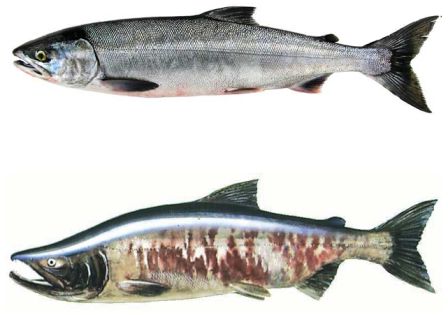 Chum Salmon
Chum Salmon
Chum Salmon get their nickname because of the dog like teeth especially the males when they spawn. They are usually the last ones to spawn and are found throughout the north Pacific. Alaskan Chum often life expectancy is about 5 years. Chum salmon reach 8-20 pounds and grow to about 18-24 inches in length. Dog Salmon are less sought after for sport and a source for fresh fish to eat. Its flesh is lighter in color and felt to be a lower in good fat. Chum salmon are more commonly used for canning or as a source of dried salmon.
Sockeye Salmon - Red Salmon
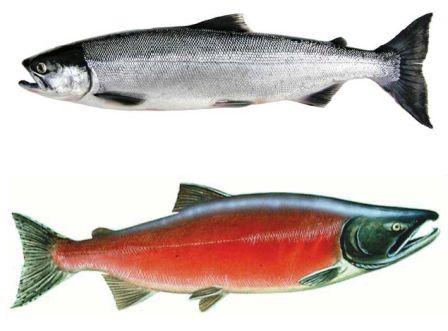 Sockeye Salmon
Sockeye Salmon
The name "sockeye" is derived from suk-kegh (s??´q?y?), its name in Halkomelem, the language of the indigenous people along the lower reaches of the Fraser River (British Columbia's native Coast Salish language). Suk-kegh means red fish. (Source Wikipedia - Sockeye Salmon) Fresh Sockeye Salmon is considered very good to eat. It's color is a bright orange or orange/red in color. Many prefer it for its flavor. Sockeye are similar in size to Chum salmon, averaging 8-12 pounds and 20-30 inches.
King Salmon - Chinook Salmon
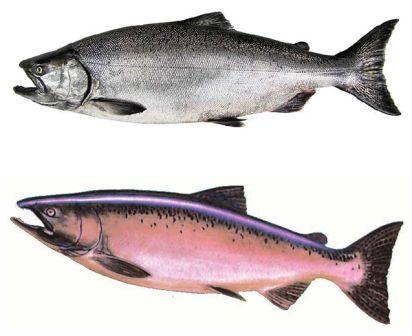 King Salmon
King Salmon
Alaskan King Salmon are the largest of the salmon species. They range in size from 30-40 inches and from 15-40 pounds. Some can grow to be even larger. These salmon are sought for both sport and commercial fishing because of their size and also their great taste. Trying to land a King Salmon on a spawning run is difficult - because of their size as well as the swift flowing waters in which they choose to make their runs. Chinook spawn in larger and swifter waters than other salmon like the copper river. Several of the great lake states have initiated a stocking program to help with the proliferation of a nuisance fish.
Silver Salmon - Coho Salmon
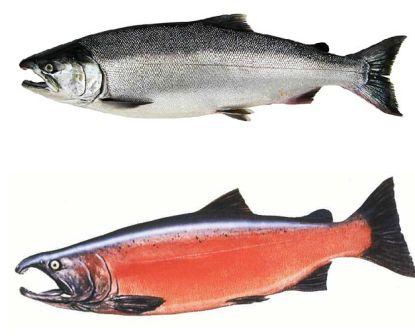 Silver Salmon
Silver Salmon
Silver Salmon are also sought after as a sport fish as well as for the dinner table. The average adult size for silver salmon is about 8-10 pounds and they can reach 20-25 inches. Adult males when spawning develop a rather hooked mouth, a slight hump on its back and very red sides. Coho Salmon has a rather high amount of fat and competes with Sockeye and King salmon for the dinner plate.
Pink Salmon - Humpback Salmon or Humpie
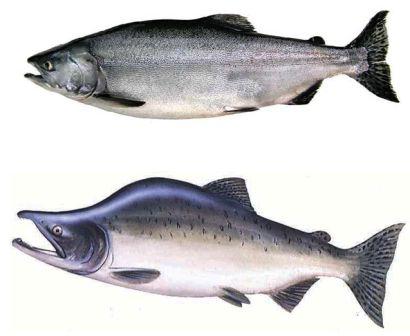 Pink Salmon
Pink Salmon
Pink Salmon are in generally the smallest of the salmon species found in Alaska. Averaging only 5 pounds the largest record Pink Salmon is 15 pounds and 30 inches. Pink Salmon also mature more quickly and typically begin their spawn when they reach 2 years of age. Perhaps the thing that is most unusual about the pink salmon is the marked hump that develops on their back when they begin their spawn. Hence the nickname "Humpback Salmon." Pink salmon are not sought after for the dinner table as much since their flavor and fat level is not as great as the others. Its meat is more of a pink color as you might expect from its name.
The content of this page came from Wikipedia, the Alaska Fish and Wildlife department and in addition observations from personal tour of the Alaskan Salmon Runs including an Alaskan Copper river fishing outing.